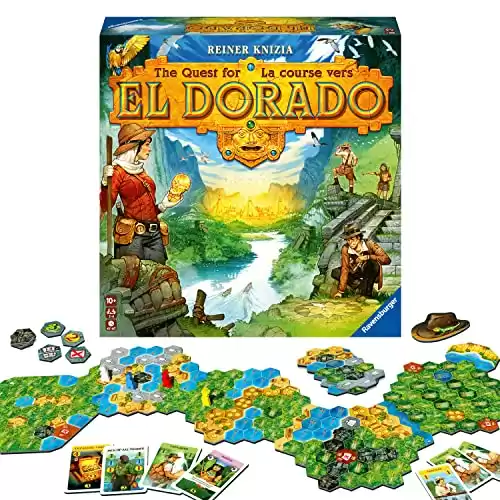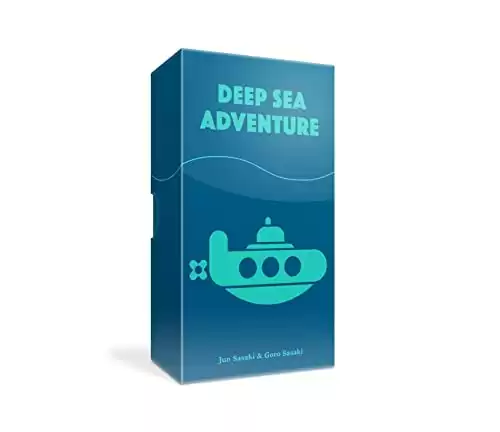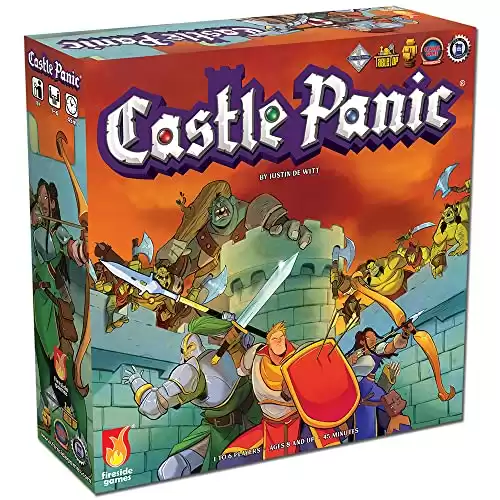
Board games for 9 year olds are drastically different in complexity, length, and tone compared to those for kids who are just a couple of years younger. Their brains develop quickly growing up and kids will need to be challenged as they get older in order to see that growth continue.
Older kids are capable of a lot more than their younger selves. They’re able to multitask better, understand strategy more, be capable of making wise choices and understand the reasoning behind them, and so much more. They’ll still experience challenges and learn new skills when playing board games for their age bracket and may need help in making decisions, but parents will certainly enjoy playing these games with their kids too and will be there to support them.
This is part of our series of board game recommendations by age. For different age groups check out our comprehensive guide to picking board games for kids.
Out Top 3 Board Games For 9 Year Olds
Below are our top 3 board games for 9 year olds. We’re confident that any of these three will be a hit with your family.
| Product Image | Product Name / Price / Primary Button | Description / Secondary Button |
|---|---|---|
|
|
|
|
||
|
|
An adventurous deck-building game with paths to victory through strategic planning.
Player Count: 2-4 players
Play time: 45 minutes
A thrilling treasure-hunting game with strategic decision-making and excitement.
Player count: 2-6 players
Play time: 30 minutes
A cooperative game where players defend their castle from monsters together.
Player Count: 2-6 players
Play time: 45 minutes
Why You Can Trust Us
At The Board Game Collection, we carefully select games that encourage fun, learning, and skill-building. We recommend games based on extensive experience, ensuring each one provides a great experience for kids while helping them grow their strategic thinking and decision-making abilities.
Deep Dives Into Our Top 3
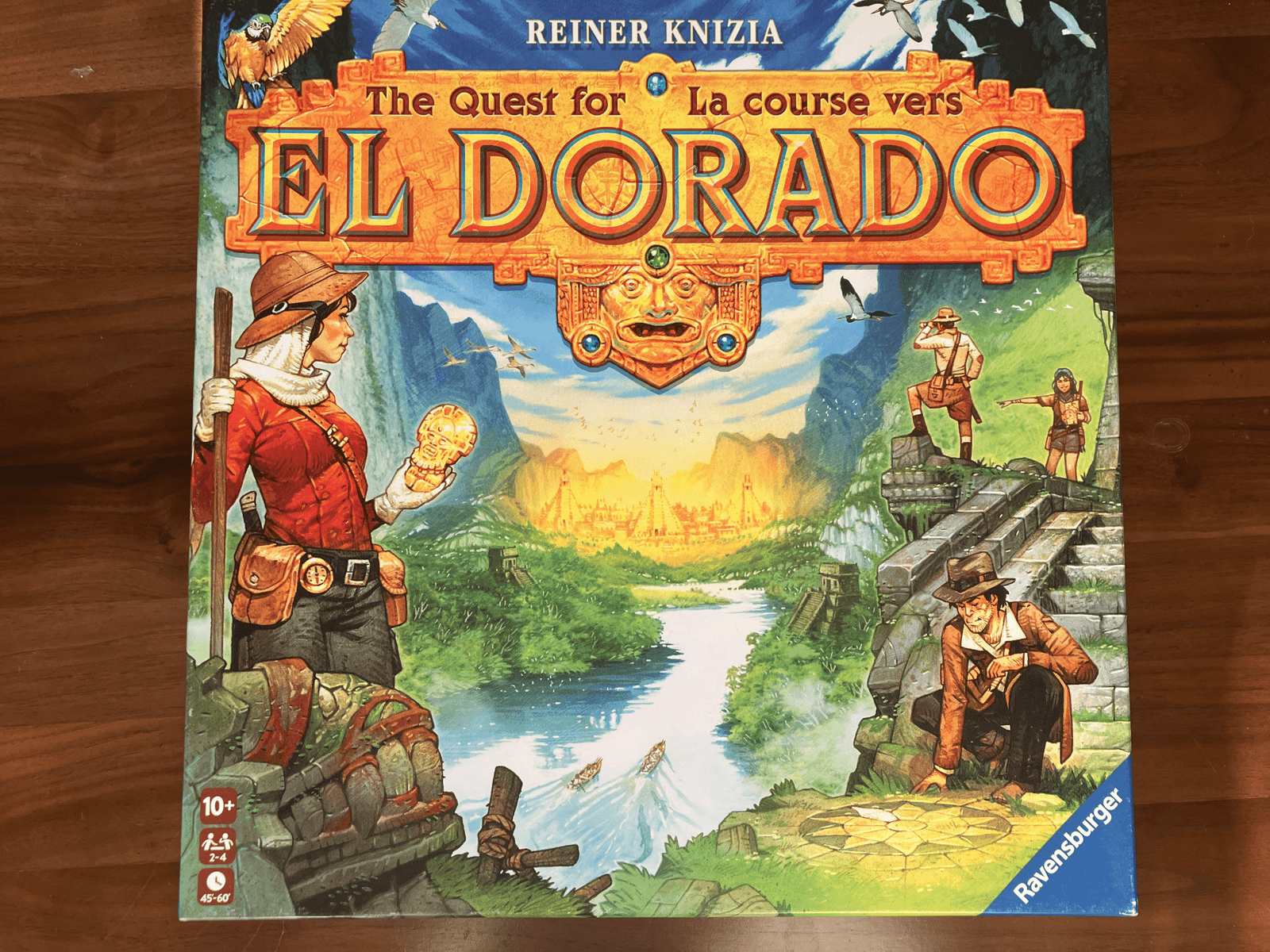
The Quest for El Dorado
By: Ravensburger Players: 2-4 Time: 30-60 minutes
Venture into the dense and uncharted jungles in search of the legendary city of gold, El Dorado. This thrilling expedition requires strategic planning, smart deck-building, and the willingness to face the unpredictable challenges of the wild.
In The Quest for El Dorado, players take on the roles of expedition leaders who guide their teams through a treacherous terrain filled with dense forests, deep rivers, and mountainous obstacles. The game combines the mechanics of racing and deck-building to create a competitive and engaging experience. Each player starts with a basic set of cards that represent various forms of movement and resources. Throughout the game, you’ll have opportunities to acquire better cards that represent more efficient travel methods and helpful equipment.
Your strategy in building a versatile and powerful deck is key to navigating the challenges of the terrain and reaching El Dorado ahead of your competitors. However, the path is not linear, and players must choose their route carefully, balancing the risk and reward of the different paths leading to the golden city.
The race intensifies as players approach El Dorado, with each decision and card play potentially determining the outcome of the entire expedition. The first player to reach the gates of El Dorado claims victory, proving themselves as the most cunning and brave explorer among their peers.
The Quest for El Dorado delivers a dynamic blend of strategy, luck, and adventure, making it a compelling game for younger kids, but one that will continue to be a family game night staple long after they are grown up.
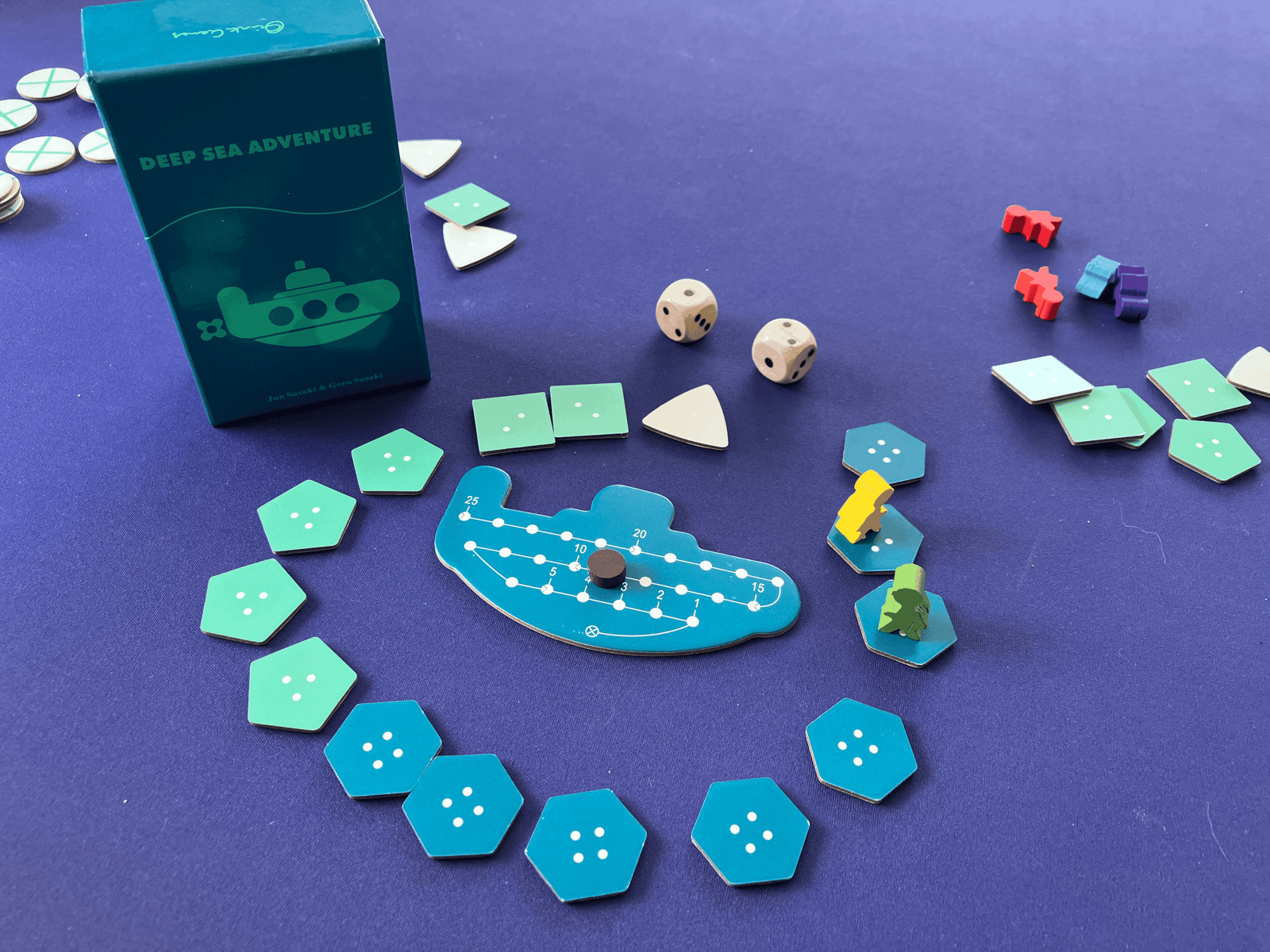
Deep Sea Adventure
By: Oink Games Players: 2-6 Time: 30 Minutes
Deep Sea Adventure is a compact, engaging board game where two to six players explore the ocean’s depths in search of treasures. It’s a perfect combination of strategy and luck, packaged in a travel-friendly size.
In this game, players are underwater adventurers, all sharing a single submarine but competing to collect the most valuable treasures from the ocean floor. Each player must manage their air supply as they descend deeper into the ocean, with every move using up precious oxygen. The dilemma between pushing your luck to grab more treasure or returning to the submarine to secure your finds adds a thrilling and exciting twist.
Players roll the dice to determine their movement, and as they collect treasures, their movement slows, making the return trip even more nail-biting as oxygen levels dwindle. The game ends after the third round, where the player who has collected the most valuable treasures and brought them back to the submarine safely wins.
Deep Sea Adventure stands out for its simple rules, quick playtime, and the unique balance of risk and reward. It encourages players to think strategically about their moves, manage resources effectively, and sometimes take risks for greater rewards. This game’s suspense and competitive nature make it a hit among nine-year-olds, offering loads of fun and excitement in a tiny package.
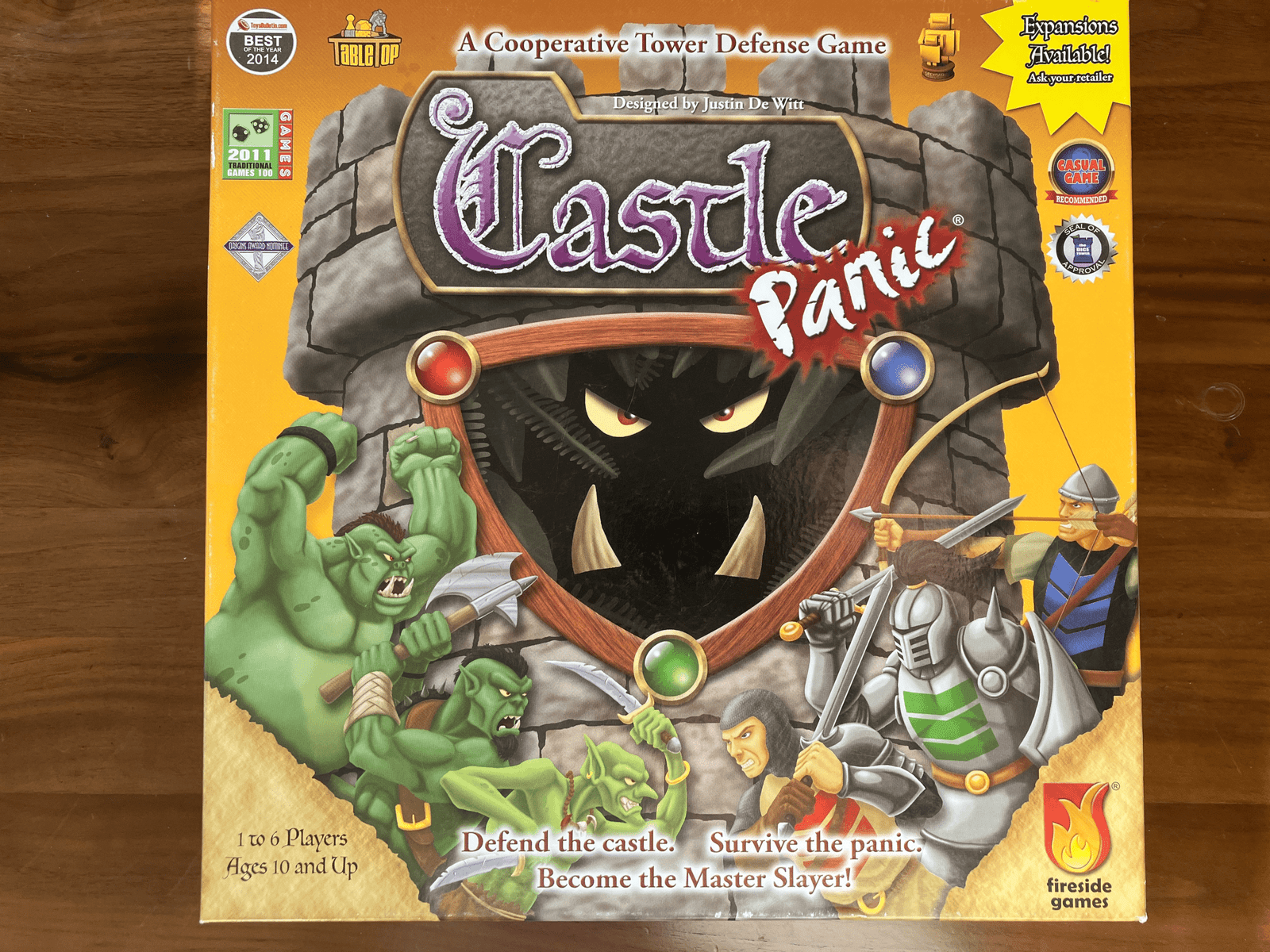
Castle Panic
By: Fireside Games Players: 1-6 Time: 30-60 minutes
The forest is filled with Goblins, Orcs, and Trolls, all mustering their forces to advance on your castle from out of the woods. Everyone must work together to defend the castle and stop the evil horde from tearing it down!
Castle Panic is a cooperative game where players must work together to stop various monsters from destroying their castle. Players win if all 49 monster tokens are slain and lose if the monsters destroy all the castle towers. The game board is marked by several rings that designate where enemies enter the board or castle components are placed, and three arcs, each a different color. The castle pieces are placed in the center of the board and made up of six walls and six towers.
Monster tokens are placed in one of the outer rings (with the remaining tokens placed face down for later) and players draw a number of castle cards into their hands to start the game. As the game is cooperative, these don’t need to be kept hidden from the other players and will be used to determine the course of action each turn.
A players turn consists of several different phases and actions. They start by drawing cards to make sure they have a full hand, can discard and draw a replacement card if they wish, or trade cards with other players if they will benefit from doing so. After this, players can play as many cards as they’re able to in order to attack and slay monsters, slow them down, rebuild walls or draw more cards!
There are certain rules around attacking monsters, like certain colored cards will attack monsters in the corresponding arcs, and if a monster receives enough hits they are slain. The player that struck the killing blow keeps the monster as a trophy, which will be used at the end of the game. After a players turn, any monster left on the board moves forward to the next ring to advance on the castle. Two new monsters are placed on the board also to bolster the monsters forces, and a new turn begins.
If all monsters are defeated, even though the game is cooperative, players can add the number of points they scored at the end of the game for each monster killed. The player with the highest score is the master slayer!
A super fun strategic board game, where victory is determined by how well everyone works together, and a healthy dose of luck. Great with plenty of players but just as enjoyable in solo mode.
- Cooperative gameplay that encourages teamwork.
- Simple rules, making it easy for new players to learn.
- Fun for families and casual gamers.
Alternative Recommendations
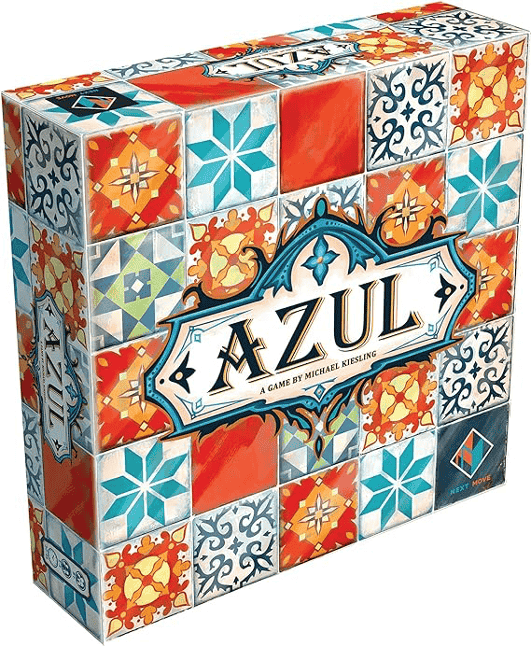
Azul
By: Next Move Games Players: 2-4 Time: 30-45 Minutes
The King of Portugal has commissioned you to create the most impressive tiled walls possible. This tile-drafting, pattern-building board game is easy to learn but difficult to master.
In Azul, players will draft tiles each turn to create the best-looking 5X5 grid, representing the palace walls of the King of Portugal. Once everyone has a player board, factory displays are placed around the center of the table. Four random tiles are placed on each of these displays and the game begins.
Each turn, players will take tiles from these displays, but must take all of the same pattern and move any leftover tiles to the center. Players can choose to take tiles from the center but these tiles must also all match. They then lay these on one of the five rows on the ‘Pattern lines’ section of their board, with any leftover tiles being placed on the “Floor line” at the bottom of the board.
Once all tiles are claimed, players move a tile on their Pattern line to their “Wall” opposite. Only if a pattern line was filled can these tiles be moved over, so the goal in the previous round is to try and fill as many lines as possible. If this can’t be done, the tiles can stay where they are until the next tile drafting phase when the factory displays are refilled with random tiles again.
Players will score points based on how many tiles were moved and if they were able to create horizontal or vertical lines with them. Any tiles that wound up on the floor then reduce the players score. The game ends when someone creates a horizontal line of 5 tiles and the player with the biggest score wins.
Azul is a beautifully eye-catching game with quality components that will keep players engaged and interested. Its simple rules combined with the emphasis on strategic choices make this game highly entertaining.
Check out our full review here.
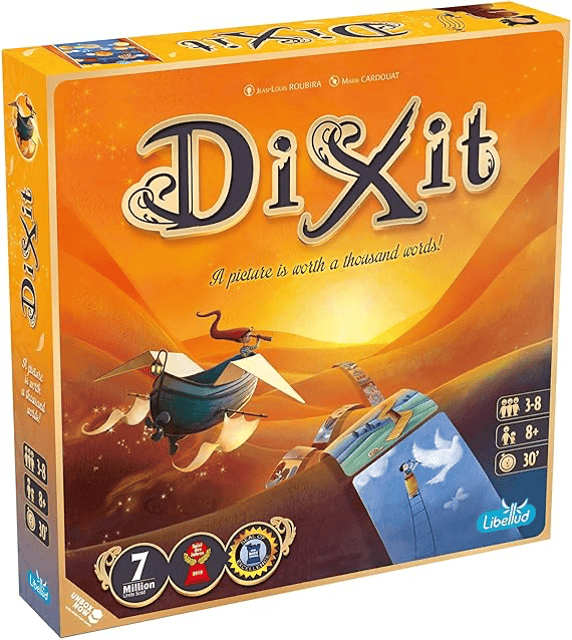
Dixit
By: Libellud Players: 3-8 Time: 30 minutes
A picture is worth a thousand words. Become a storyteller and use your imagination to associate creative illustrations with a word or phrase and see if players can guess which image was yours amongst everyone else’s.
Dixit is played using hundreds of beautifully illustrated playing cards. Players are given a hand of these cards and take turns being the ‘storyteller’. On their turn, they must be as creative as possible and use a word or phrase to describe their card whilst keeping it hidden from the other players. This is not always an easy task as most of the cards are very surreal and explaining what they see on their card in a handful of words can be tricky.
Once everyone else has selected a card they feel best reflects the phrase or word, the storyteller mixes all the cards and places them face up. Other players then vote on which card they think is the storyteller’s. The trick on a player’s turn as storyteller is to be ambiguous enough that some but not all other players can recognize which card is theirs.
If all or none of the players can identify the correct card, the storyteller scores zero points. As long as some but not all players guess correctly, then the storyteller receives points. Any players whose card is guessed as the storytellers will also receive bonus points. As you can see it’s a delicate balance between being too vague and too obvious!
Play will continue in this way with players alternating the role of storyteller until one player collects 30 points and is declared the winner! Not only are there plenty of cards in the base set to get the creative juices flowing, but there are literally hundreds of other cards obtainable through the many expansions available.
Dixit, like any good party game, is light on rules but big on fun. A perfect game for arty or creative types, it engages children’s creativity and imaginations like very few other games can, resulting in a truly entertaining experience.
Check out our full review here
- Encourages creativity and storytelling.
- Easy to learn, great for all ages.
- Visually stunning with unique art.
- Limited strategy, more reliant on imagination.
- Can feel repetitive after several plays.
- Best with larger groups, less exciting with fewer players.
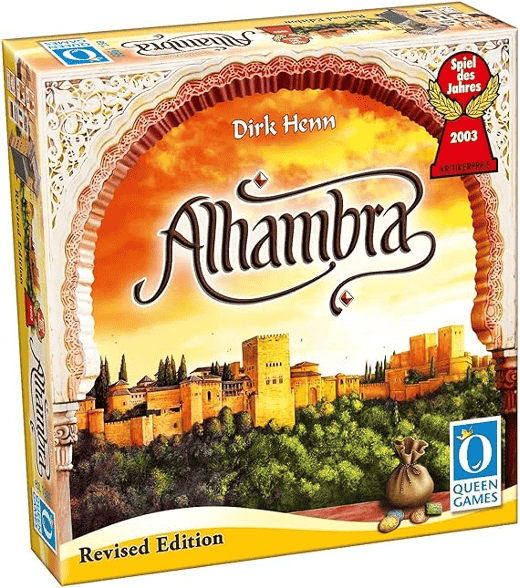
Alhambra
By: Queen Games Players: 2-6 Time: 45-60 minutes
As one of the best master builders in Europe, you’ve been commissioned with helping to construct the now-famous Alhambra complex during the Spanish middle ages. Construct towers, gardens, pavilions, arcades and more!
In Alhambra, players construct buildings from tiles that form a complex, and will score points based on the number of a particular kind of building they have erected, as well as the size of the wall around them. Each player starts the game with a fountain tile that acts as the center of their Alhambra.
Every turn a player can do one of three things: take money, buy and position a building tile, or redesign their Alhambra. There will be four money cards of differing value and currency, and a player may choose to take one or more than one, as long as the value doesn’t exceed five. Like the money cards, there will always be four building tiles available, and a player can purchase one as long as they have both the right amount in the correct currency. If a player can pay the exact amount without going over, they can take another turn if they wish to.
Purchased tiles can be placed in the Alhambra or the reserve board, which comes in useful when it comes to redesigning. If a player wants to redesign their Alhambra they can exchange tiles or place a tile from their reserve into their Alhambra (and vice versa). When placing tiles, everything must be the right way up, tiles with or without walls must be connected, and each tile must be connected by at least one side.
Once all building tiles are gone the game ends. Points are dictated by scoring cards and players with certain types of buildings will score more points, as well as points for how long their wall is at the end of the game.
Alhambra is a very strategic game and relies on forward move planning skills and predicting what other players may do on their turn. Definitely a game for those who excel at big-brain plays!
Check out our Full review here
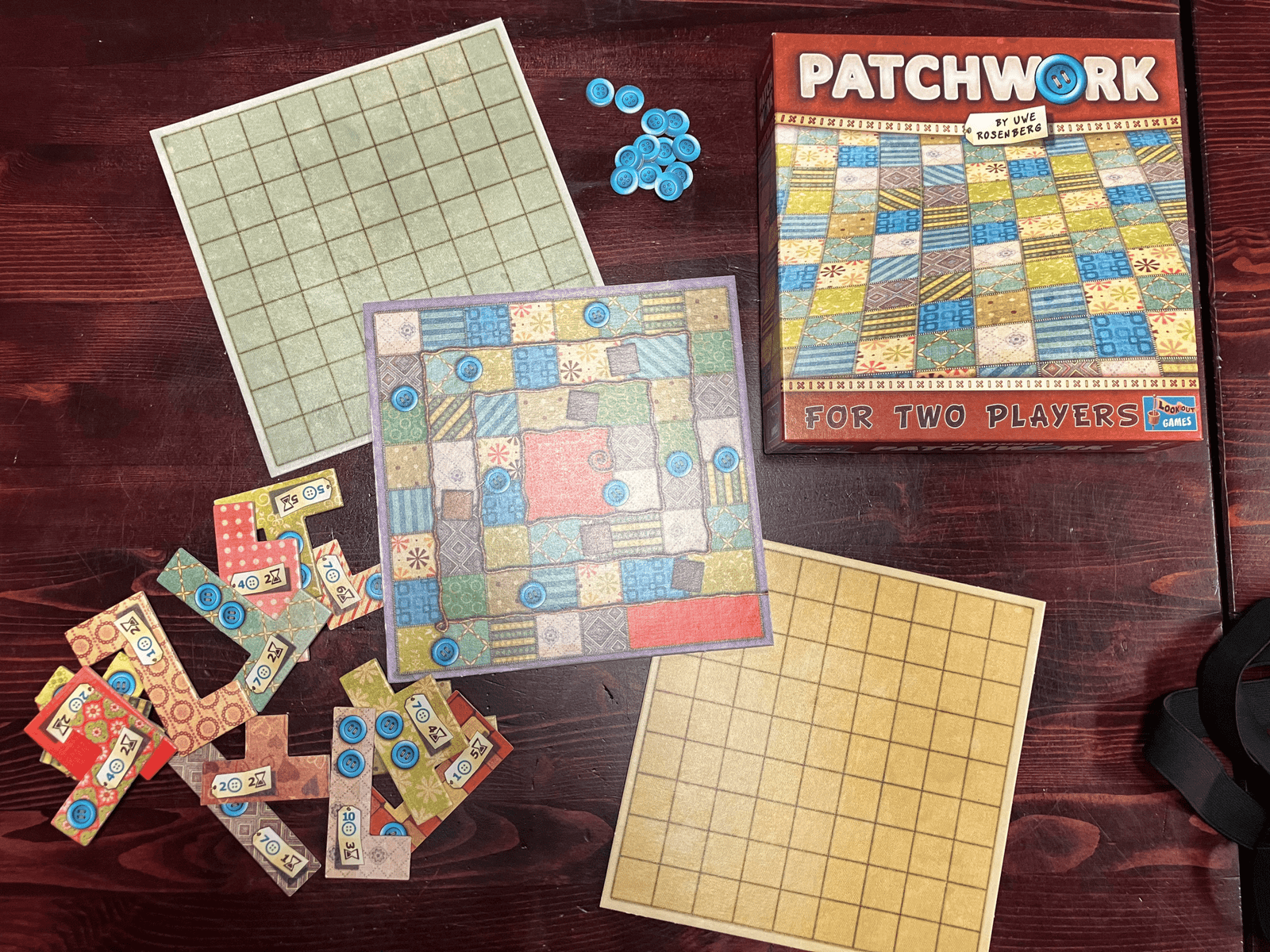
Patchwork
By: Lookout Games Players: 2 Time: up to 30 minutes
A chilled-out puzzle game for two players. Create a beautiful quilt and keep a healthy stock of buttons to score big.
In Patchwork, players will take turns selecting tiles of all different shapes and sizes to create the largest and most beautiful quilt possible. At the start of the game, all tiles are spread out around the main game board and each player takes a personal game board, which they’ll use to create their quilt.
During a player’s turn they’ll take one of two actions: buy a patch to lay on their personal board or move their token around the main game board. Players can purchase one of three patches, which changes every time a player purchases a patch, with buttons they’ve obtained by moving their token. When a tile is chosen and placed on the players board, they then move their token around the main board a number of spaces indicated on the tile they just played.
If, instead of buying patches, a player wishes to move their token, they can move as many spaces as they wish and can collect as many buttons as spaces they’ve moved. If they also pass over a button, they receive an additional amount of buttons equal to the number of buttons on their quilt. Only when a player’s token is in first place does play switch to the other player. If a player utilizes the right strategy, they can move and collect tiles several times before play changes hands.
After a while, the game can feel like you’re playing a colorful version of Tetris. Players will need to utilize the space on their personal board and cover as much of it as possible as any empty spaces will result in points being deducted at the end. This can be easier said than done as the choice of tiles each turn is limited, so making use of the space that’s left efficiently can be tricky.
Once a player reaches the end of the main game board the game ends. Points are calculated by adding up the number of buttons a player has and subtracting a point for each space left on their board. The player with the most points wins.
Patchwork is a simple, short, and enjoyable game that’s stress-free and anything but tense. With the vast array of tiles available, it’s fun making all kinds of patterned quilts with each new playthrough. A great game you only need one other player to play.
Check out our full review here
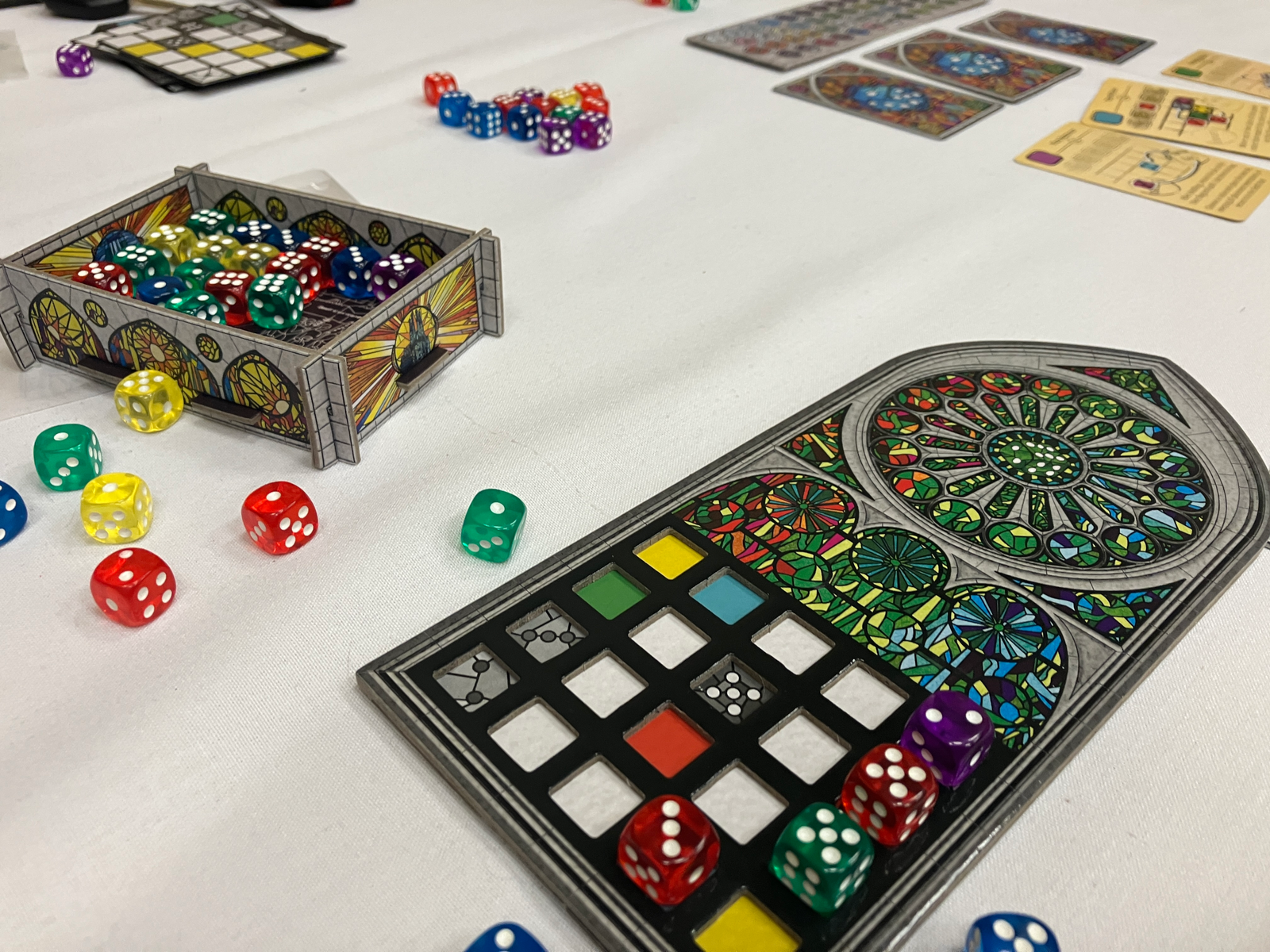
Sagrada
By: Floodgate Games Players: 1-4 Time: 20-40 minutes
Sagrada is a visually striking board game that challenges players to construct the most beautiful stained glass window masterpiece using colored dice. Inspired by the famous Sagrada Familia Basilica in Barcelona, the game is as aesthetically pleasing as it is intellectually stimulating.
At the start of the game, players choose a window pattern card that outlines the framework of their window — each with a unique distribution of restrictions on which dice colors or numbers can be placed there. The game proceeds over ten rounds, with players drafting dice from a pool each turn to place onto their window, observing the placement rules derived from traditional stained glass artistry.
The strategic depth of Sagrada lies in balancing the dice selection and placement. Not only must the dice adhere to the color and number constraints of the window pattern, but they must also follow the rule that the same numbers or colors of dice cannot be adjacent to each other. Players can also use special ability cards to bend the rules in their favor, adding an additional layer of strategy.
Scoring in Sagrada is based on achieving various patterns and color combinations as outlined by public objective cards, in addition to personal secret objectives. Efficient use of limited resources, foresight, and adaptability are key, as players compete to accrue the highest score and claim the title of the greatest artisan of the Sagrada Familia.
Sagrada is a unique blend of visual appeal and cerebral challenge, offering a serene yet competitive gameplay experience that can be enjoyed by families, casual gamers, and strategic minds alike. Plus, everyone loves rolling dice.
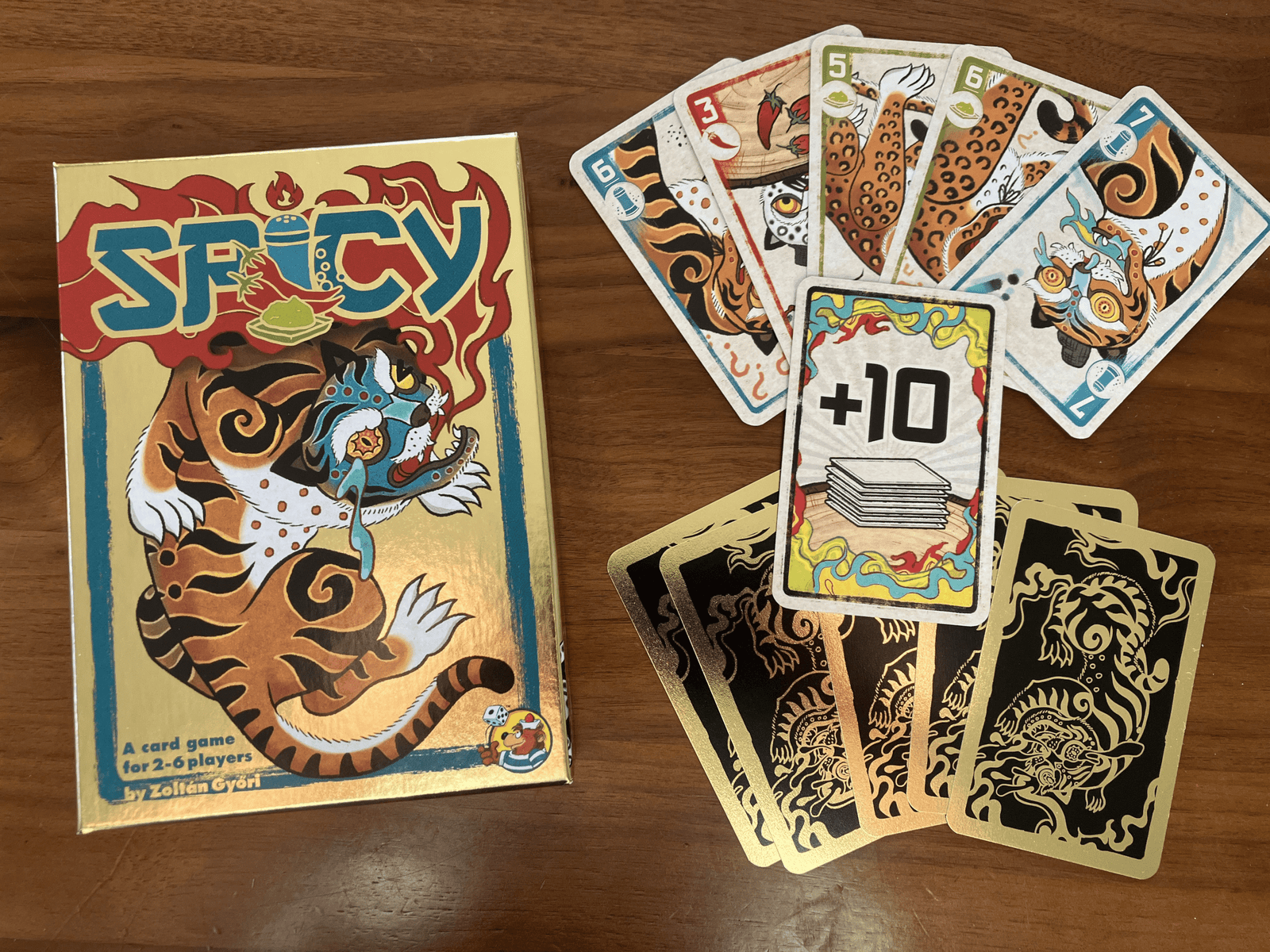
Spicy
By: HeidelBÄR Games Players: 2-6 Time: 15-20 minutes
Spicy is a fiery card game of bluff and deduction, where players vie to become the top cat in a wild contest of spicy food. Set in a whimsical universe where daring felines push their luck in a legendary spice contest, the game’s charm is matched only by its simplicity and depth of strategy.
Each player starts with a hand of cards representing different spices: Pepper, Wasabi, and Chili, each numbered from 1 to 10. The game’s primary mechanic hinges on challenging your opponents’ claims about the cards they play face down, attempting to out-bluff and out-think them.
On a player’s turn, they proclaim what card they are playing (e.g., “Pepper 5”)—but here’s the catch: they may be lying. The next player must then either escalate by playing a higher card (in number, spice, or both) or challenge the previous player’s claim. If a challenge is made, the truth is revealed. A successful challenger wins the round, but failing means giving the advantage to the challenged player.
The deck also includes action cards that can change the game’s flow, providing opportunities to peek at the deck, play additional cards, or force an opponent to play first.
The player who successfully gets rid of all their cards first or has the least number of cards when the deck runs out wins the game. Victory in Spicy requires a clever balance of deceit, strategy, and sometimes, a willingness to take the heat.
This quick and engaging card game, with its sleek design and competitive gameplay, promises bursts of laughter and excitement. It’s a perfect appetizer for game night or a spicy finishing touch!
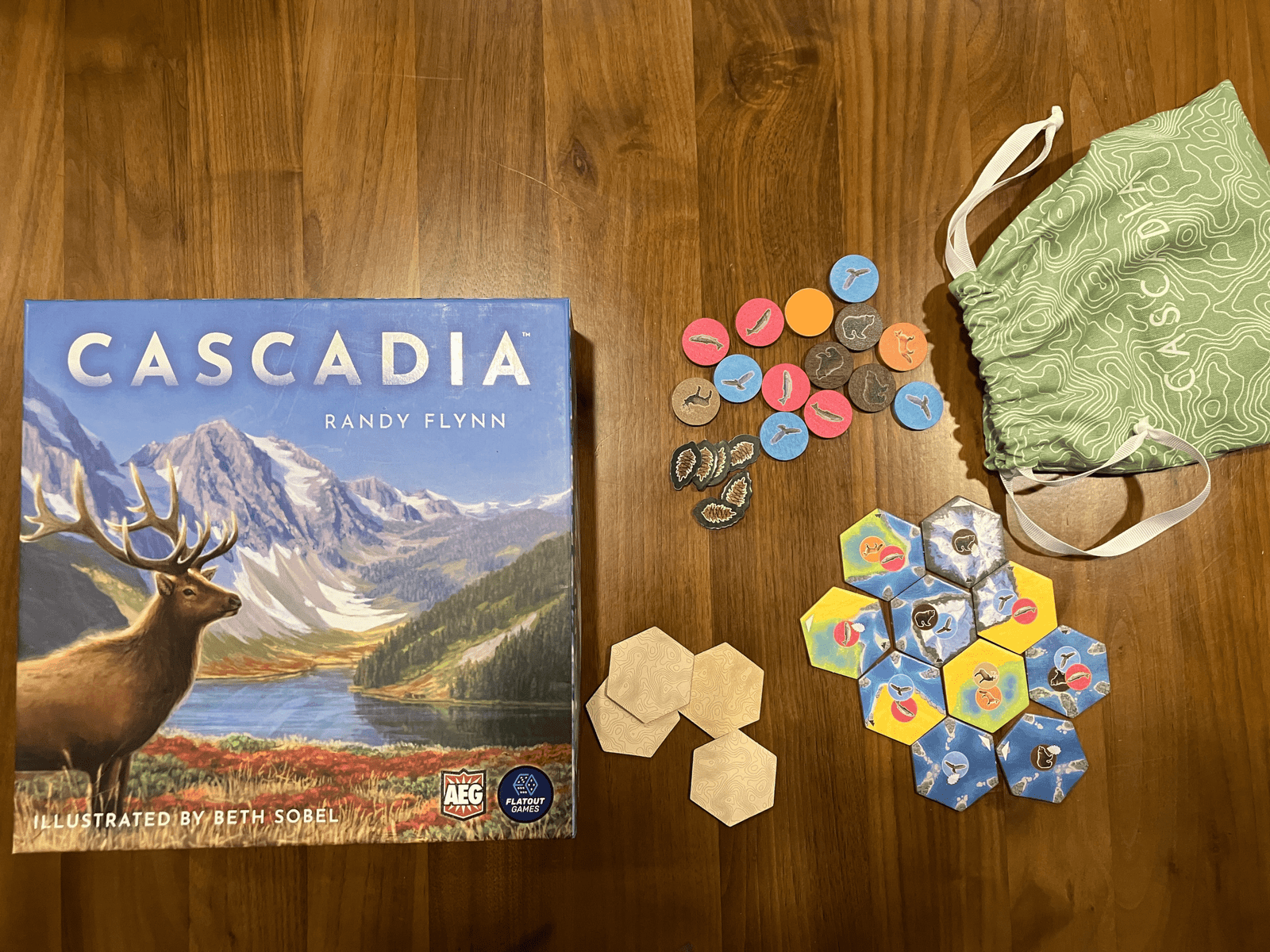
Cascadia
By: Flatout Games Players: 1-4 Time: 30-45 minutes
Cascadia is a captivating strategy board game that transports players to the lush, diverse landscapes of the Pacific Northwest, where they work to create the most harmonious ecosystem. The game stands out for its theme of conservation and wildlife, blending strategic tile-laying mechanics with token drafting to simulate the complexity of habitat creation.
In Cascadia, players take turns selecting terrain tiles and wildlife tokens to assemble their own section of the Pacific Northwest. Each tile represents different types of habitats such as forests, rivers, wetlands, and mountains. The wildlife tokens, which include species like bears, salmon, and foxes, must be placed on the appropriate terrain tiles. The goal is to create contiguous habitats and groupings of animals in patterns that align with the available scoring cards.
The strategy in Cascadia involves not only choosing the right combination of habitat and wildlife for current scoring opportunities but also anticipating which patterns will be most beneficial as the game progresses. Each animal species has a unique scoring rule, adding depth and variability to the game. Players must also contend with the limited availability of tiles and tokens, making each choice crucial for achieving the most points and creating a balanced ecosystem.
Cascadia offers a serene yet engaging gameplay experience, enhanced by its beautiful artwork and environmental theme. It’s a game that appeals to families, casual gamers, and enthusiasts alike, providing a peaceful yet challenging puzzle that celebrates the beauty of nature.
A game that combines strategy, adaptability, and a love for the natural world, Cascadia is a must-play for anyone who enjoys games that are not only engaging but also evoke a sense of wonder and appreciation for the environment.
Conclusion: every board game is a party game with a nine year old
In today’s board game market, there is no shortage of diverse and exciting games to choose from. Whether you’re a fan of cooperative games, bluffing and deduction mechanics, or strategic tile-laying challenges, these games offer something for every taste.
From the fast-paced game of Deep Sea Adventure to the fiery intensity of Spicy and the serene beauty of Cascadia, the world of board gaming continues to expand and innovate, promising new experiences and endless hours of entertainment for the entire family. So turn off the video game for a night. Skip more traditional board games or card games collecting dust in the closet, and try one of the best board games for kids from our list above.
FAQ
Where can I purchase these board games?
Most of these board games can be found at your local game store, online retailers, or directly from the publishers’ websites. We recommend supporting local game stores whenever possible!
Are these board games suitable for children?
Yes, these are, we believe, the best board games for kids – selected specifically with kids ages nine and up in mind. With adult supervision and guidance, younger kids can enjoy these games too, but you’ll have to keep your child’s skill level and attention span. Spicy and Cascadia are great family games, though keep in mind the strategic depth for younger players. Deep Sea Adventure requires strategic thinking and might be more suitable for older children.
Can these board games be played in larger groups?
While Deep Sea Adventure and Spicy accommodate up to six players, Cascadia is designed for up to four players. For larger groups, up to eight players, consider playing in teams or setting up tournament-style play where winners from smaller groups face off in the final round.
How long does it take to learn these board and card games?
These games are designed to be accessible, with rules that can generally be explained in under 15 minutes. The actual mastery of the games, however, will develop over time as players explore different strategies.
Are there expansions available for these board games?
Currently, Spicy does not have an expansion, but Cascadia does. The board game community is always evolving, so it’s worth keeping an eye out for future expansions – especially for great games like the one in our list. Publishers often announce expansions based on the game’s popularity and community feedback.
Can these board games be played solo?
Cascadia offers a single player game where players can challenge themselves against set scenarios or try to beat their highest score. Deep Sea Adventure and Spicy are primarily multiplayer experiences, though creative gamers might find ways to adapt the gameplay for solo play.

